Create an Amazon Wedding Registry

Register a SNAP EBT card with Amazon
A Ewer from Nagyszentmiklós
Horseman and captive
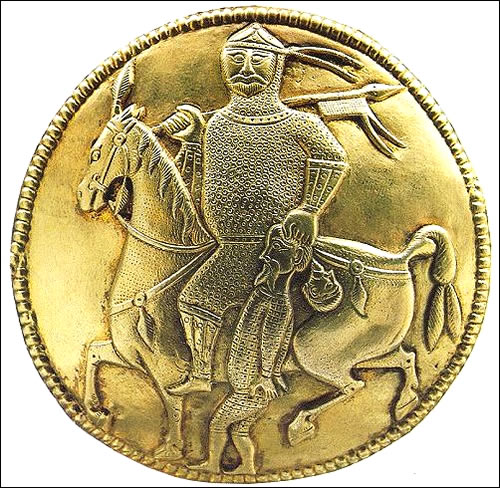
Referenced as figure 445 in The military technology of classical Islam by D Nicolle
445. Gold ewer, Nagyszentmiklos Treasure. 8th-9th centuries AD, north Caucasian (?), Kunsthistoriches Museum, Vienna (Laz N).
An extract from volume 2 of The military technology of classical Islam by D Nicolle
326
The magnificent Nagyszentmiklos treasure from Hungarian Transylvania is a case in point, and a very important one. Its golden ewer illustrates two warriors, an archer riding a mythical beast and a cavalryman with a prisoner (Fig. 445).101
A strong Sassanian influence in the purely decorative aspects of this ewer have often been remarked. The equipment is, however, more Central Asian in style. The archer uses the thumb-draw with a rather crudely represented type-A bow, comparable to an 8th or 9th century example excavated at Moshchevaya Balka in the north Caucasus (Fig. 411A).
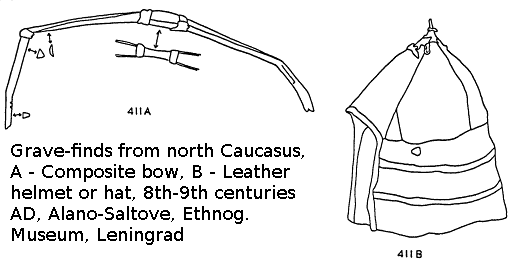
411A and 411B. Grave-finds from north Caucasus, A - Composite bow, B - Leather helmet or hat, 8th-9th centuries AD, Alano-Saltove, Ethnog. Museum, Leningrad (Jer, Milov).
One feature of the horseman himself also demands immediate comment, and that is his clear lack of stirrups. It seems highly unlikely that an artist who has put such effort into rendering every other item of armour and equipment would simply forget to include stirrups, particularly as grave-goods indicate that various nomadic peoples considered stirrups important enough to be buried with the deceased. Obviously, this horse-warrior either comes from a time before stirrups appeared, or was one of a tribe or people who were slower than their neighbours in adopting the new device. This would suggest a close proximity to Sassanian or immediately post-Sassanian Iran where stirrups do not seem to have been generally adopted before the late 7th or early 8th centuries (Figs. 331 and 339).
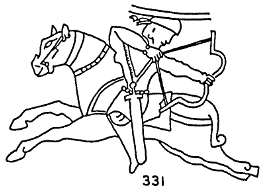
331. Bronze ewer, undated late Sassanian or early Islamic, Lewisohn Coll., New York (Pope).
This ewer illustrates other interesting items of harness and decoration, such as the throat tassel. Tassels under horses' throat lashes are rarely seen at Piandjikent (Fig. 436), but are apparent a little later in 8th century art from the same area
(Figs. 443
and 444).

436. Fresco from Piandjikent Room VI/41, 7th-8th centuries AD, Transoxanian, Hermitage, Leningrad (Aka S, Yaku).
101. G. Lászlo and I. Rácz, A Nagyszentmiklosi Kincs, (Budapest 1978),
pp. 187-188.
327
They had, of course, been common in east Turkistān (Figs. 61A
and 466) and China under "barbarian" rule since the 6th century. This form of decoration also appears at early 7th century Sassanian Ṭāq-i-Bustān, with so much other horse-furniture of Central Asian origin (Fig. 330).
As a last decorative feature there is the knotting of the horse's tail. This is again first seen in Sassanian Iran (Figs. 339
and 341), although here the pattern so formed generally consists of a single loop. Such a fashion was to persist in Muslim Iran. Although a double-loop was sometimes represented, as on the Nagyszentmiklos ewer, it was not to be widely seen until the Seljūq invasion. To this one must add an incident related by al Balādhurī, concerning a raid by Yazīd ibn al Muhallab against al Qīkān in Afghanistan in the year 664/5 AD. "He met eighteen Turkish horsemen riding horses with shortened (maḥdhūfah) tails. They attacked him but were all slain. Al Muhallab then remarked: How much faster at manoeuvering their horses were these barbarians than we were. He (therefore) had the tails of his own horses shortened and was the first Muslim to do so."102 Perhaps the tying of the tail of one's horse was in general a Turkish fashion, while the two-loop style might have been specifically west-Turkish.
Various items of the warrior's own equipment may also help identify his origins. The pennon on his lance, for example, is identical to some seen at Piandjikent (Figs. 429 and 439), while a similar form with four rather than two streamers appears on the controversial "Siege" silver plate from Turkistān, now in the Hermitage. This latter piece of metalwork will feature prominently in a later chapter.

439. Fresco from Piandjikent Room XXI/1, 7th-8th centuries AD, Transoxanian, Hermitage, Leningrad (Aka S, Yaku).
102. Al Balādhurī, op. cit., p. 608.
328
The warrior's spangenhelm, with its long helmet-laces, could be Sassanian or Turkistānī. Its pointed shape recalls the latter while its straight brim, helmet-laces and lack of cheek-pieces draws one towards the-former, The closest parallels are perhaps found in Iran (Figs. 41 and
330) and the 5th century Avar Crimea (Fig. 101). Yet there are enough similar helmets in both west
(Fig. 444) and east Turkistān
(Fig. 454) to prevent this helmet from helping us overmuch. The same goes for his mail aventail. Indeed the rider's short-sleeved mail hauberk could come from anywhere in western, though probably not eastern, Turkistān.
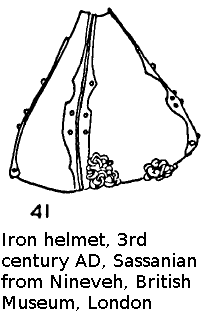
41. Iron helmet, 3rd century AD, Sassanian from Nineveh, British Museum, London (Rob OA).
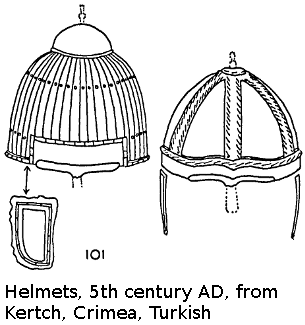
101. Helmets, 5th century AD, from Kertch, Crimea, Turkish (ex-Thor A).
Finally, there are those extraordinary splinted vambraces and greaves whose construction seems to have no parallel outside Dark Age England (Fig.
553) and Scandinavia. Of course, the 7th century Nordic world was under strong Central Asian influence via trade, though those Nagyszentmiklos limb defences are more likely to have been local and perhaps simplified versions of those laminated vambraces and greaves seen at Piandjikent and elsewhere in Turkistān.
This sum total of evidence is not necessarily as contradictory as it might at first seem. The dominant influence on the armour and equipment of the Nagyszentmiklos ewer is clearly Central Asian, in particular from the western Turkish and Transoxanian region. Subsidiary influences were Sassanian Iranian and, to a lesser degree, Romano-Byzantine. Thus we may be drawn to the Caucasus region, probably to those steppe-lands to the north of the mountains. Hence my own preference is for a late 7th or early 8th century, Alan or Khazar, origin for the Nagyszentmiklos ewer. If this is correct, then it would thus have come from an area recognized not only as a major iron-mining and arms-producing centre, but also as a region rich in gold, silver,
329
copper and lead.103 Such a conclusion could also shed a great deal of light on those arms-rich regions that were to remain Islam's northern, and often belligerent, neighbours for many centuries.
103. Lombard, Les Ménaux, passim.
Back to more images of the Ewer from Nagyszentmiklós.







